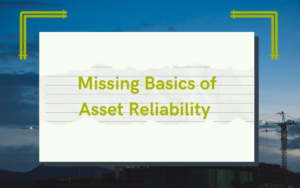Managing assets in an asset-intensive business can be difficult if you do not have a system to help keep track of every little detail. An asset hierarchy is a tool in your EAM/CMMS solution that can improve asset management – it keeps a record of all your assets and details. However, your asset hierarchy must be constantly maintained and updated; otherwise, obsolete data can slow down your business. Common asset hierarchy slip-ups can undermine the usefulness of your EAM/CMMS. Learning how to prevent consequences from asset hierarchy slip-ups is a good decision for bettering future operations.

Missing Data
The most common asset hierarchy slip-up would be a disorganized hierarchy with missing asset data and basic details. The missing asset details will be important for future use in maintenance, planning, and scheduling.
Lack of Details
You need more details to know what assets you have – this makes it difficult to order the correct parts when writing a work order. If your assets are tagged and included in your asset hierarchy, you will not need to physically check the equipment and parts you need to order. Missing basic details can also lead to inefficiencies in communication, production operations, and worker productivity. Read “Missing Basic Asset Information and Its Impact” for more information. Your asset data should always be fully populated, and descriptions should always be included to prevent future slip-ups from an improper asset hierarchy.
Criticality
Suppose your asset hierarchy doesn’t have past failure and performance data recorded. In that case, it can be challenging to conduct a criticality analysis to help your organization determine which asset requires a priority fix. Not being able to investigate past failures will lead to improper risk management – a costly mistake.
Consequences!
The consequences of slipping up with your asset hierarchy can snowball and make everyday operations difficult to handle.
Difficulties with Everyday Activities
You will need help planning and scheduling preventative maintenance with missing details. A common mistake is recording only some maintenance detail and failure data in your asset hierarchy, which makes it more difficult to analyze past data to make better plans for the future. An incomplete asset hierarchy always makes ordering parts difficult because you need clarification on the correct spare part to order. In an asset-intensive business, you can have thousands of assets, and if one is unaccounted for, you will spend much time figuring out the correct spare part to order. Missing asset details can lead to future inefficiencies, so you should always ensure everything is complete.
Reliability Problems
Unreliable asset data cause reliability problems from asset hierarchy slip-ups. If your asset data is unreliable, you can’t trust what you have recorded and need to do it in person to ensure that everything is correct, which can waste much time you could spend being productive in more critical matters.
NRX AssetHub for Slip Prevention
NRX AssetHub is the go to solution to prevent future slip-ups with unreliable asset hierarchies. Our solution provides everything you need to reorganize and standardize your asset hierarchy to prevent problems with unreliable data by making sure everything in your asset hierarchy is populated correctly. Download our brochure and book a demo to start the process!
Asset Hierarchy - EAM Priority Fix
Missing Basics of Asset Reliability
The Impact of Poor Asset Data on Your EAM/CMMS Effectiveness

Share this article



